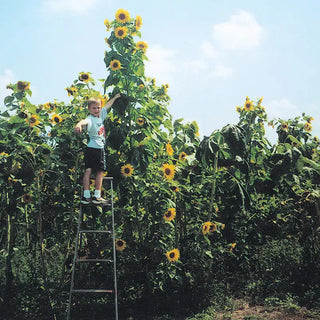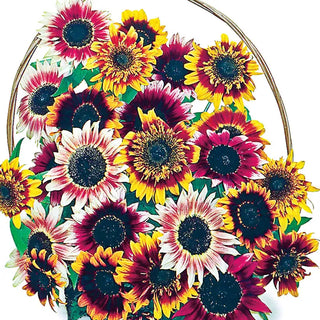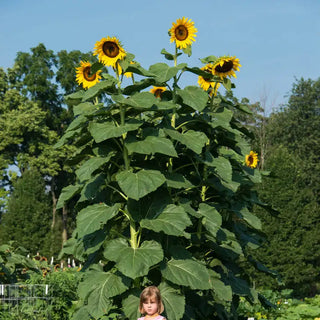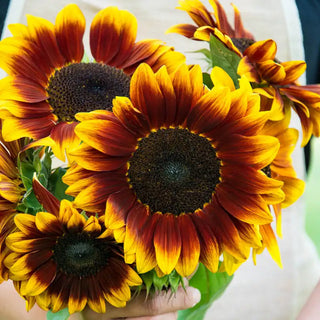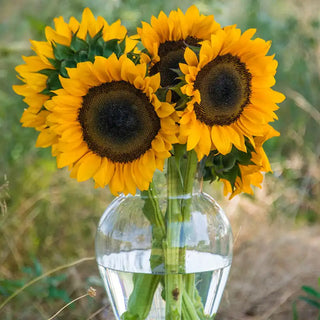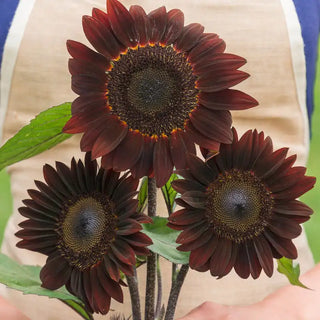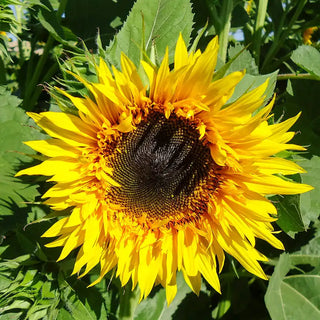So bright and cheery, it's easy to see why gardeners find room for sunflowers. Gurney's carries a wide selection of these American natives—from 2-ft. dwarf varieties to sunflowers that grow up to 12-ft. tall. Sunflowers' bold, daisy-like flowers brighten gardens and landscapes, look great as cut flowers Plant sunflowers as a hedge, along fencerows or in the garden.
Sunflower Seeds for Sale from Gurney's
With our Gardening Guarantee, you can trust that we provide high-quality sunflower seeds. Known for their stunning blooms and easy care, sunflowers brighten gardens and make perfect additions to pollinator-friendly spaces.
How to Save Sunflower Seeds
To save sunflower seeds, allow the flower heads to dry on the stalk until the back of the head turns brown, and the seeds loosen easily. Cut the heads and place them in a dry, well-ventilated space for further drying. Rub the seeds gently off the flower head and store them in an airtight bag or glass container in a cool, dark place. Properly stored seeds can remain viable for up to 2 years.
How to Plant Sunflower Seeds
Sunflowers grow best when they are sown outdoors. After the last frost date, plant seeds in loose, well-drained soil.
- Planting Depth: Sow seeds at a depth of 1 inch.
- Spacing: Space seeds 6-12 inches apart, depending on the variety.
- Water: Water gently after planting to ensure soil contact without displacing the seeds.
When to Start Sunflower Seeds
Direct sow sunflower seeds in the garden after the last frost, when the soil has warmed to at least 50-60°F (10-15°C). For an extended bloom period, plant seeds in succession every 2 weeks through early summer.
How Long Does It Take for Sunflower Seeds to Germinate?
Sunflower seeds typically germinate within 7-10 days under optimal conditions. Warmer soil temperatures and consistent moisture can speed up the process.
How to Grow Sunflower Plants
- Planting: Direct sow in full sun with well-drained soil enriched with organic matter.
- Watering: Water seedlings regularly but avoid waterlogged soil. Mature plants are drought-tolerant but benefit from consistent watering.
- Support: For tall varieties, use stakes or plant near fences to protect against wind damage.
- Fertilizing: Sunflowers thrive with a light application of balanced fertilizer or compost at planting. Avoid over-fertilizing, as this can promote foliage over flowers.
- Spacing: For large blooms, thin seedlings to 12-24 inches apart.
Sunflowers require 6-8 hours of full sun each day. They are fast-growing and can reach their mature height within 60-90 days.
Are Sunflowers Easy to Grow?
Sunflowers are incredibly easy to grow, making them perfect for gardeners of all skill levels. They tolerate a wide range of soil conditions, require minimal care once established, and attract pollinators such as bees and butterflies. Many varieties are drought-tolerant, thriving even in less-than-ideal conditions.
Common Pests and Insects on Sunflowers
- Aphids: Sap-sucking pests that cause distorted growth. Wash them off with water or use insecticidal soap.
- Caterpillars: Larvae that chew through leaves. Hand-pick caterpillars or use natural controls like Bt (Bacillus thuringiensis).
- Sunflower Moths: Larvae tunnel into the flower heads, damaging seeds. Cover heads with mesh to protect them.
- Birds: Birds often feed on sunflower seeds. Use netting or allow them to enjoy their feast near season’s end.
- Squirrels: These animals love sunflower heads. Protect plants with wire cages if necessary.
Regular monitoring and natural deterrents can keep sunflowers healthy and productive throughout the growing season.




